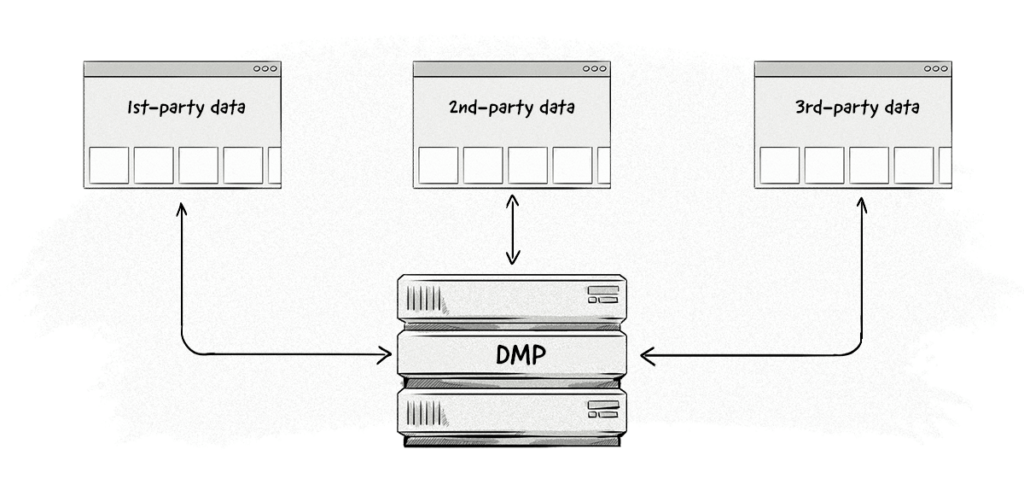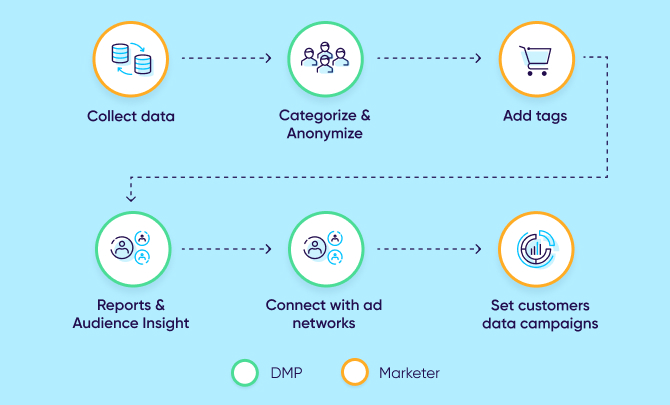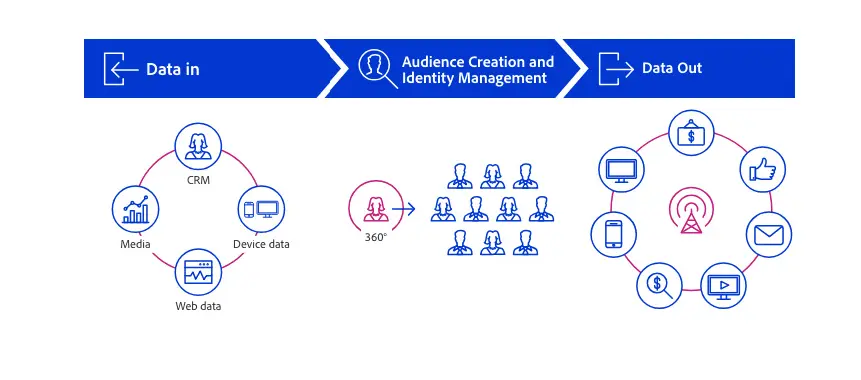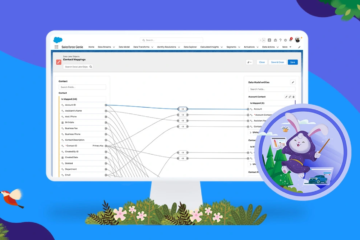Today, We are going to discover how data management platforms can empower marketers to tackle growing data challenges, create powerful customer insights and set up marketing campaigns that increase revenue and a significant decrease in media wastage.
Data-driven marketing – three words that set a challenge for marketers and publishers alike, yet offer incredible opportunities at the same time. The sheer scale of the data available to businesses is daunting, hence the challenge to manage and make sense of this data is ever-more critical.
What are our expectations/Wants from digital marketing?
- Businesses want to improve their product or service offerings for consumers and increase their ROI.
- Marketers want to improve their communication with their consumers.
- Publishers want to improve their offering for their readers and advertisers.
- End Users want toreceive only Relevant communications about services, products, and offerings.
Now our Goal is to make a strategy by which we can achieve what we want. Most of the companies have or can acquire significant data about behaviors, preferences, needs, and choices of people who are customers or potential customers. Transforming this data into powerful insights about the client’s journey that will be used to help Businesses, Marketers, Publishers and End Users alike.
Hence the arrival of the Data Management Platforms (DMP) has emerged to help marketers, publishers. It helped the wider marketing community make sense of data across digital, and non-digital, channels of contact with people, be it the web, mobile, social, e-mail, display, search, point-of-sale, call centers and more.

DMP and three types of data: infographics
The increasing recognition within organizations that they are sitting on a treasure trove of data from various channels, partners, Analytics Warehouse and data abundance from third party data providers has helped to fuel a rise in investment in data management. Marketers, agencies, and publishers are starting to spend significant money on technology assets such as DMPs, to make the use of their data, and from the customer insights buried within, make the resulting communication more efficient. All of us have recognized that:
- Communications with clients and potential clients are becoming increasingly technology-based.
- Harnessing and mastering masses of data is now critical in achieving competitive advantage.
- Many budgets are changing in favor of digital investment.
As I have already mentioned that all of us have data abundance, However, the heart of data management, and specifically a DMP, is not the data. It is not the algorithm. It is not the code or the numbers. The heart of a DMP is the customer or prospective customer. It is the behaviors, the preferences, the decisions and the choices of these people; which will fuel a DMP.
If you understood this different than your DMP becomes a tool to turn devices into people, to stitch together a user across a website, an app and the mobile web, offline channels and then use this information to optimize user journey each step of the way as they interact with your brand.
What are the benefits of DMP?

How do a DMP functions?
Well working of DMP is three steps process, and I am going to explain that to you below.
[Tweet “1-2-3 for Data management platforms: Collection, Synthesis, and Activation “]
1. Data Collection:
The DMP collect all the data about existing and prospective customers. Most of the Companies have a wealth of data generated from analytics, comments and preferences shared in a company’s social media channels, Data from Mobile App and rich offline data such as CRM. CRM houses years’ worth of information related to customer purchase history and complaints and what not. Moreover, finally, there is the data from the realm of others (second and third-party data). All of this data will be collected into a DMP by a real-time process gathering algorithm once integrated.
2. Data synthesis:
Once you have completed/automated the data collection process to ingest it into a DMP, you can use the following techniques to convert this into valuable insights and develop new audiences that are in line with your business challenges and your customer (and prospect) behaviors.
- Cohort Analysis: will help you understand users behavior as the cohort so you can use this to recognize your prospects and clients expectations (Learn more about cohort analysis).
- Advanced cross-channel communications analytics: will help you to make smarter channel selections.
- Algorithmic modeling: will allow you to automatically model new audiences, and deliver more intelligent communications to them in the future.
- Customer/prospect segmentation: will also help you to become smarter when it comes to targeting, and in reducing media waste.
3. Activation/execution:
Use the juicy segments that you have created in above to personalize consumer experience across your digital platforms, improve media buying/ efficiency and monetize by delivering targeted, one-to-one cross-channel messages to users(via Marketing automation tool, i.e., Adobe Campaign). The communication which we sent in this process will have a measurable impact on conversion.
Data Management Platforms Architecture in a nutshell:
DMP, Marketer’s Disparate Data Sets, And Live Marketing Channels.
The DMP Is The Audience Intelligence Engine For Interactive Marketers:
Data intake and aggregation: the ability to ingest and aggregate data from first, second, and third-party on and offline sources in a unified (and increasingly programmatic) manner.
Segment building and manipulation: functionality that allows a marketer to combine data sources to build custom audiences flexibly.
Universal container tag: An unlimited tagging solution provides many benefits including consistent and accurate data collection, increased labeling flexibility, and reduced organizational friction.
Self-serve user interface: a web-based interface for direct access to tools, features, and centralized reporting and analytics.
Linkages to appropriate channel environments: Integrations with proper channels — including site side, display, and email today, with search and video likely to soon follow — that allow a marketer to find, target, and serve relevant messaging to segments.
The DMP Creates A Single View Of The User
Marketers have traditionally managed multiple views of a single user, housed within channel specific execution tools and personal media or technology partners. The DMP becomes the repository of a marketer’s user-level data drawn from multiple sources. This centralized view creates many benefits. It:
- Enables data freedom and portability: The DMP allows marketers the opportunity to develop proprietary (and private) audience segments that exist outside of individual media partners and channel execution tools. Data portability and Interchangeability allows marketers to move between performance partners quickly.
- Reduces waste: Marketers can use the tool to identify audience overlap among partners, resulting in a more efficient budget allocation among media and data vendors.
- Enables brand consistency across channels: Through the application of channel-independent audience segments, marketers can more easily create brand experiences that are both customized and consistent across channels.
What are the most common uses of a DMP?
Let’s find out about the amazing use cases of DMP in the current digital marketing landscape.
Ad targeting:
Wouldn’t you want to be able to ‘slice and dice’ your first party data by audience type, by campaign or even by revenue generation outcome, and then enrich it with second- and third-party data? To be able to create user segments that can, when targeted carefully, positively impact the business objectives? No wonder so many companies are excited by DMPs.
Media buying:
Businesses and their media agencies have utilized the segmentation offering of a DMP to help further in the automation and delivery of their digital media buying. With marketers sharing the selected audience segmentation with their media buyers. However, the fundamental truth is that a DMP offers an opportunity to secure media buying efficiency for a marketer. Media buying intelligence in DMP is perhaps better described as helping create media efficiency by excluding known users in media buys and thus significantly reducing wasted media spend.
Customer and prospect insight:
Many brands use a DMP to understand their customers better. Brands and publishers can generate a comprehensive understanding of their site visitors, from shopping intent and demographics to geo-location or business profiles.
Content optimization/personalization:
More and more companies are moving towards delivering a personalized multi-channel customer experience. A DMP helps optimize content based on both the audience type and their history. For example, if you have added some items to your basket via your desktop and then log on via your mobile later in the day you will be shown the basket page again, allowing brands to offer a seamless brand experience.
What is Adobe Audience Manager?
It is a data management platforms Which have all the essential characteristics of a DMP explained above; that helps you build unique audience profiles so you can identify your most valuable segments and use them across any digital channel.
- Understand your audiences: Get a complete view of your audience by combining all of your data sources in one place.
- Create new segments: Continually discover and organize new, valuable segments for smarter targeting and personalization.
- Advertise effectively: Make your ad campaigns more productive by targeting specific segments on any platform.
What can Audience Manager do?
Adobe Audience Manager is a perfect DMP which follow all the guidelines for a DMP. In layman terms, AAM analyses your existing customer and build a formula from that data and applies that method to all your general users and generates a list of reliable list of prospect for targeting for you.
Following Diagram from Adobe explains the AAM working.

Audience Manager working overview summary
List of available features from Audience Manager:
- 360-degree profiles: Combine information from online, offline and second- and third-party sources to create complete audience profiles.
- Audience activation: Conveniently target specific profiles on any content delivery platforms, like content management systems and ad servers.
- Cross-device measurement: Identity, measure and target people as they move across screens and devices.
- Look-a-like modeling: Identify prospects who are similar in behavior to your most valuable customers so you can extend your reach.
- Create new segments: Continually discover and organize new, relevant segments for smarter targeting and personalization.
- Customer Intelligence: You need to know how your audience interacts with your content and advertising, so you can create relevant experiences and quickly change course if something is not working. AAM can build models based on past behavior of your customers to predict future success.
It is the ability to tie a thorough understanding of these personality drivers with purchase behavior that fundamentally changes the game. Integrating psycho-graphic profiling with the end-to-end customer experience information – from browsing history to buy – provides a marketing team with the quantitative certainty required to understand exactly who is buying from them and why.
Embedding psycho-graphic and motivational insights within the existing data layer enable the CMO to take more accurate decisions around marketing strategy and budget allocation, prioritize activity and create actionable plans that deliver measurable return on investment and realize that vision of a truly engaged digital customer base.
Now we understood that key for a successful marketing campaign is to identify the Customer Motivation. Use a visual campaign orchestration, to create an integrated customer profile and apply targeted segmentation to stitch a channel agnostic customer journey to engage your customer to your brand. In plain language “Provide them what they want from your brand, and you will get what you want from your clients.”
Audience Manager helps you manage your data pipeline. The service is a catalyst that transforms general users and raw data signals into actual audience segments used for multi-channel marketing efforts. Additionally, Audience Manager provides tools for tag management and audience analytics while simultaneously meeting the privacy and data security needs of clients and consumers. Adobe Audience Manager helps you identify your most valuable segments and use them across any digital channel.

